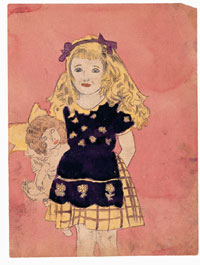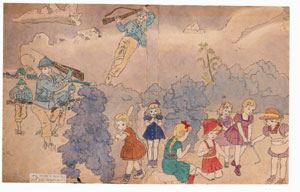Back
The Secret World
of an Outsider Artist:
An exhibition currently
on view at The Andy Warhol Museum reveals the prolific and
eccentric work of Henry Darger, an artist unknown to the
world until his death in 1973.
By Graham Shearing,independent art
critic
Outsider artists commonly live the creative part of their
lives hidden from the world, only to be discovered and celebrated
in old age or after their deaths. Darger is considered an outsider
artist, which means his work falls outside the traditions of
art making. Often, the mad or the dysfunctional, or the untrained,
primitive artist finds a home in this genre. Outsider art catches
us off-guard with its raw, sometimes strange, and often unrefined
insights.
Darger is best known for his hundreds of odd watercolor
drawings of young girls, soldiers, and dragons set in picturesque
landscapes,
which are often threatened by tornadoes, or disrupted by
warfare or other acts of unexpected violence. Simply and colorfully
illustrated, the illustrations, which can be up to nine feet
long, double-sided, and stiff with adhering collage, were
once
bound up together accompanied by 30,000 pages of text, including
the masterpiece he titled The Story of the Vivian Girls,
in what is known as the Realms of the Unreal, of the Glandeco-Angelinnian
War Storm, Caused by the Child Slave Rebellion. If not for
the scale of the work, the strangeness of the accompanying
story’s content, and the enormity and consistency of
the vision, Darger’s drawings would be nothing special.
The Lonely Misfit
Darger experienced what can only be described as a horrible
life. His mother died in childbirth when he was 4. His only
sister was adopted and totally lost to him. His father placed
him in an orphanage at the age of 8, and he spent his adolescence
in an asylum, declared weak-minded. As a child, he witnessed
a traumatic tornado in his hometown just outside Chicago,
which was to haunt his memoirs and his art. As an adult in
Chicago, he barely
scraped by on his janitorial pay.
 Right: Study
Of Vivian Girl With Doll, Right: Study
Of Vivian Girl With Doll,
Watercolor, carbon tracing, and pencil on paper. Collection American Folk Art
Museum, New York. © Kiyoko Lerner.
Descriptions of Darger indicate
a cantankerous misfit, scavenging from dumpsters, disconcertingly
dressed. However, he appears
to have been a devout Catholic and a regular at mass.
When
he became too frail to navigate the stairs to his apartment,
Darger handed over its entire contents to his landlord
and submitted himself to the care of the Little Sisters of
the
Poor to await death. And yet, from that single-room apartment
emerged one of the world’s most distinctive artists.
We know what Darger wrote and how he wrote it. His autobiography,
which is 5,000
pages long, and other matter found in his apartment—all
equally as obsessive — constitutes a formidable archive,
much of which is housed in the Henry Darger Collection at
the American Folk Art Museum in New York City. Andy Warhol,
at
one stage of his career, sat on the board of the Folk Art
Museum, and his own collection of folk art was once exhibited
there.
We also know how Darger constructed
his remarkable pictures.
In fact, his methods of working are the principal reason
why he attracted the interest of The Andy Warhol Museum.
John Smith,
The Warhol’s assistant director for collections and
research, aware of the connections between Darger and Warhol
and recognizing
other interesting technical parallels in their work jumped
at the opportunity to bring Darger’s work to Pittsburgh. “
Warhol himself had a very distinctive method, which has
a great deal in common with Darger’s,” says
Smith. “Both appropriated the work of others,
particularly illustrations and advertising material, which
was not necessarily regarded as art. And, like Warhol,
Darger was a pack rat, exhibiting unusual collecting obsessions
beyond the material that fueled his art. For Warhol, it
was cookie jars; for Darger, empty Pepto-Bismol bottles.”
A
curator once warned Warhol of the risks of duplication;
for Darger, duplication was his lifeblood. Although Warhol
was a highly accomplished artist, he devised
simple
methods of copying images such as tracing, reversing images,
and photographic enlargement. Darger, claiming no graphic
skills, reproduced his images by similar methods.
Both
reproduction and enlargement dilute the affective quality
of the original image. But Darger’s little girls, whether
traced or collaged onto his drawing paper, make a virtue
of their monotonous duplication. Armies of clones are the
unexpected result. The formula is unceasing, the repetitive
pattern
and
succession of bright, flat coloring—which imitates
lithographic reproductive methods—echo Warhol’s
own banal use of color and design.
Simple Methods, Complex
Art
While much of Darger’s work, at first glance, appears
to have much in common with a child’s coloring book
(Warhol also produced such things), it has no such recipient
in mind,
and beware the parent that introduces such work to his
or her child.
 Left:
At 5 Norma Catherine. but are retaken, Henry Darger (1892-1973),
Chicago, Illinois; mid-twentieth century, Watercolor, pencil
and carbon tracing on pieced paper. Collection American Folk
Art Museum, New York. © Kiyoko Lerner. Left:
At 5 Norma Catherine. but are retaken, Henry Darger (1892-1973),
Chicago, Illinois; mid-twentieth century, Watercolor, pencil
and carbon tracing on pieced paper. Collection American Folk
Art Museum, New York. © Kiyoko Lerner.
There is an obvious theme to Darger’s
drawings that is violent and perversely sexual. The sequences
of little girls
that he illustrates with such obvious relish are often
naked and equipped with penises. This has given rise to
complex psychosexual
theories about Darger’s private life.
Scenes of
violence, young girls brandishing guns, and soldiers
throttling girls against a background of threatening
skies
(that tornado again) contrast with sylvan landscapes,
brilliant skies, banks of flowers, and the innocent
play of children.
It is as if a hellish Apocalypse has come to visit
a rural kindergarten. Theories abound that attempt to explain
Darger. It has been suggested that he was a child murderer
because newspaper
clippings of a particular incident were found among his
papers,
but there’s
no evidence of that. In fact, his life offers no evidence
of perversion of any kind. Yet his drawings seem to demand
an
explanation.
Students of the art of the insane, a very
distinct sub-category of outsider art, often see work
of this kind. But for
art like this to have been created outside of the walls
of
an asylum
and within the secret places of our contemporary cities
may make us all catch our breath.
Smith takes a broad
view of the artist: “The beauty of
Darger’s work is that it lends itself to so many
interpretations. In the absence of any statements from
Darger himself that might
offer interpretative clues or signposts, we are all—curators,
art-historians, dealers, critics, psycho-historians,
and the public—completely free to read Darger’s
work according to our own intuitions and self-interests.”
One
thing is surely certain: had Andy Warhol lived to
continue his own obsessive habits, at least one
watercolor
by Henry
Darger would have entered his collection. Smith also
speculates that had Warhol never gone to Carnegie
Tech or to New York,
his impulse to create might well have resulted in
work not unlike that of Darger.
The ‘definitive’ exhibition
of Darger’s work
is on view at The Warhol until April 30, although Smith
stresses: “Consider
the fact that Darger’s work has only recently
been accessible. It’s clear that there remains
a tremendous amount of research still to do.”
Back | Top |